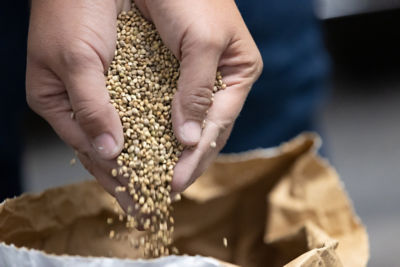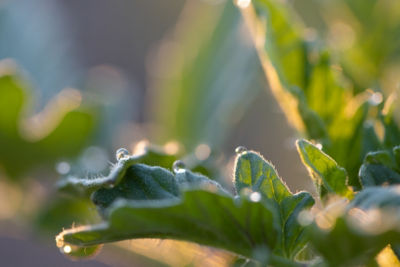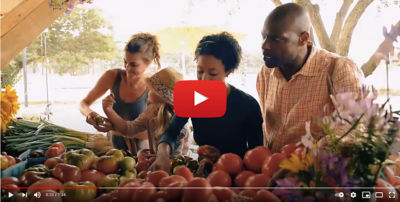Click here to download a PDF version of this spotlight.
» Damping-off can result in substantial stand reductions in vegetable crops.
» Several fungal and water mold pathogens can cause damping-off.
» Damping-off is often favored by cool, wet conditions that slow germination and seedling growth.
Damping-off is an early-season disease affecting many vegetable crops. Damping-off is defined as “the death of a seedling before or shortly after emergence due to decomposition of the root and/or lower stem; it is common to distinguish between preemergence damping-off and postemergence damping-off.”1 With pre-emergence damping-off, seeds and seedlings are affected during or after germination but before emergence resulting in poor stands. If seedlings emerge and then wilt and collapse, that is called post-emergence damping off.2,3
Damping-off can be a problem in open-field, high-tunnel, and greenhouse production systems. There is a window of susceptibility to damping-off from pre-germination to the time when the first few true leaves are produced, with seedlings becoming less susceptible as they develop.2,4
PATHOGENS
Damping-off is caused mostly by fungal and water mold (oomycete) pathogens. Common fungal pathogens include species of Botrytis, Fusarium, Rhizoctonia, Sclerotinia, and Thelaviopsis. The oomycete pathogens include species of Pythium and Phytophthora.2,3,5 These pathogens tend to have wide host ranges and are commonly found in field soils as soil inhabitants or surviving on crop debris. Species of Fusarium and Rhizoctonia often attack seedlings at the soil line and cause post-emergence damping-off. Pythium and Phytophthora species often attack plant parts below the soil surface.4,6 Some of these pathogens, such as Phytophthora, also cause roots and crown and fruit rot diseases on older plants.
SYMPTOMS
Symptoms of preemergence damping-off include decay of seeds (Figure 1) and rotting of radicles and hypocotyls.Failure of seedlings to emerge is often the first indication of a dampingoff problem. When dug up the seed or seedlings can be rotted (soft and mushy) with gray-brown discoloration of the radicle, hypocotyl, and cotyledons. Threadlike, fungal growth (hyphae) may be seen on and around the affected tissue.2,4,5,6
 Figure 1. Seed rot causes pre-emergence damping off. Gerald Holmes, Strawberry Center, Cal Poly San Luis Obispo, Bugwood.org.
Figure 1. Seed rot causes pre-emergence damping off. Gerald Holmes, Strawberry Center, Cal Poly San Luis Obispo, Bugwood.org.
Common symptoms of post-emergence damping-off include root decay and rotting of the lower stem, usually at or below the soil line. Affected tissues can be water-soaked, mushy, and show a brown-gray or green-gray discoloration (Figure 2A). In some cases, lesions on the roots and lower stems can be dark brown, reddish-brown, or black discrete, dry, and sunken. When severe, lesions can girdle the stems of young seedlings resulting in wilt followed by collapse and death of the seedling (Figure 2B).4,5,6
 Figure 2. (A) A seedling with a rotted hypocotyl. (B) Belowground damage can result in seedling wilt. Gerald Holmes, Strawberry Center, Cal Poly San Luis Obispo, Bugwood.org.
Figure 2. (A) A seedling with a rotted hypocotyl. (B) Belowground damage can result in seedling wilt. Gerald Holmes, Strawberry Center, Cal Poly San Luis Obispo, Bugwood.org.
Both pre- and post-emergence damping-off can be limited to just a few plants, or the problem can be extensive, requiring replanting of fields or transplant trays.6 Some abiotic factors can result in symptoms similar to those of damping-off, including excessive fertilization, drowning, drought/desiccation, excessive heat or cold, and chemical injury. The patterns of occurrence can help distinguish damping-off from abiotic disorders. Damping-off tends to occur on a random scattering of plants or in patches, while abiotic disorders tend to appear more uniformly over the planting or in some regular pattern often associated with cultural practices such as planting, spraying, or cultivation.5
DAMPING-OFF IN TRANSPLANT PRODUCTION
In transplant production systems, inoculum of damping off pathogens can be present on infested pots, tools, and greenhouse surfaces. Pathogens can also be introduced in infested potting mixes. Pathogens can be spread by insects, splashing or flowing water, and on tools and workers’ hands and clothing.2
Managing damping-off can include practices to lower pathogen inoculum levels. This is accomplished more easily in greenhouse transplant production systems than in open field systems. Damping-off pathogens can survive on used pots, flats, trays, tools, and greenhouse surfaces. Therefore, sanitizing tools, pots, and surfaces before use will help manage damping-off.2,4,5 Several types of sanitizing agents are available. Products vary in how corrosive they are, the length of residual activity, and the range of pathogens they are effective against.6,7
Contaminated planting mixes can also be a source of inoculum; thus, only newly opened bags of sterilized planting mixes should be used. Bags that have been open for a long time can become contaminated. Bags should be opened and used on a clean, sanitized surface. Potting media should not be reused. Hoses and watering heads used for irrigation should be kept off the greenhouse floor to help avoid contamination.2 With direct seeded crops, crop rotations of three years or more can help keep the inoculum levels of some pathogens low. Certified, disease-free seeds should be used.4
Fungicides are another tool that can be used to help manage damping-off. However, certified disease-free seeds planted into sterilized soilless mixes usually do not benefit from seed treatment fungicides, and fungicides are usually not used to treat sanitized soilless mixes.3 If fungicides are to be used as drenches or for foliar applications in the greenhouse, they must be labeled for that purpose.
Managing the environment can also help prevent damping off. Ensuring good drainage of the potting mix and avoiding over-watering will help make conditions less favorable for damping-off.2,5,6 Using warming pads under pots and flats to keep temperatures in the optimal range for the crop and watering with warm water will help seedlings germinate and grow faster. Apply ¼ strength fertilizers to seedlings after they have produced several true leaves. Do not apply additional fertilizers if the potting mix contains a slow-release fertilizer.2 Provide supplemental lighting if ambient light levels are insufficient to sustain adequate growth and development.6 If symptoms of damping-off start to appear, stop watering plants to let them dry out somewhat and increase the air circulation around the plants.8
DAMPING-OFF IN DIRECT SEEDED CROPS
In direct-seeded crops, damping-off is usually more severe when the soil conditions are cool and wet. Cool conditions slow seedling growth and extend their window of susceptibility. Wet conditions favor the germination and growth of many fungal pathogens. Pathogens such as Sclerotinia and some species of Pythium and Phytophthora grow best in cool, wet conditions, increasing their ability to infect. A few pathogens, such as Rhizoctonia solani, Sclerotium rolfsii, and some species of Fusarium, are favored by warm and somewhat drier soil conditions.3,5 Inoculum can be found in the soil, on crop debris, and introduced in contaminated irrigation water. Some damping-off pathogens can be seedborne.4
Delaying planting until soil temperatures are in the range to support good plant growth is recommended for direct-seeded crops.6 Planting on raised beds can help improve soil drainage and help increase soil temperatures early in the season. Seeds should be planted at the depth and seeding rate recommended for the crop.3,5,6
Fungicide applications to the seed or soil can help protect seeds and seedlings from infection by damping-off pathogens. Seeds pre-treated with fungicides can be purchased, or seeds can be treated after purchase. If growers are treating seeds themselves, they should select products that are labeled for that use on the crop to be treated and known to be effective against the target pathogens.5 Some seed-treatment fungicides, such as Captan Fungicide and Thiram® Seed Treatment, are effective against a fairly-broad spectrum of fungal pathogens. Other fungicides, such as metalaxyl, have a narrower spectrum of activity.3,4
Some fungicides can be applied in-furrow at the time of planting or as foliar spays to emerging seedlings to help manage damping-off. If possible, the pathogens likely to be present should be identified so that the appropriate fungicides can be selected. As with seed-treatment fungicides, the fungicides labeled for soil application vary in their spectrum of activity against different pathogens.5 Consult current local production and pest management guides for registrations, rates, and restrictions, as labeled uses can change.4 Soil-fumigation before planting can also be used to help manage damping-off.7
SOURCES
1 D’Arcy, C., Eastburn, D., and Schumann, G. 2001. Illustrated glossary of Plant Pathology. American Phytopathological Society. https://www.apsnet.org/edcenter/resources/illglossary/ Pages/default.aspx.
2 Grabowski, M. 2018. How to prevent seedling damping off. University of Minnesota Extension. https://extension.umn.edu/solve-problem/how-prevent-seedlingdamping#:~:text=Damping%20off%20affects%20many%20vegetables,trays%20of%20 seedlings%20are%20killed.
3 Egel, D. 2020. Damping-off of vegetables. Purdue Vegetable Crops Hotline. Issue 671.
4 Gauthier, N. and Rudolph, R. 2022. Damping-off of vegetables & herbaceous ornamentals. University of Kentucky Extension, Plant Pathology Fact Sheet. PPFS-GEN-03.
5 Meadows, I., Sharpe, S., and Henson, M. 2020. Damping-off in flower and vegetable seedlings. NC State Extension.
https://content.ces.ncsu.edu/damping-off-in-flower-and-vegetable-seedlings.
6 Melanson, R. 2022. Damping-off in vegetables. Mississippi State University Extension. Publication Number P3747.
7 Denny, G. 2020. Choosing a disinfectant for tools and surfaces in horticultural operations. Mississippi State University Extension. Information Sheet 1955 (POD-12-19).
8 Damping-off in vegetable seedlings. Pacific Northwest Pest Management Handbook. https://pnwhandbooks.org/plantdisease/pathogen-articles/common/fungi/damping-vegetable-seedlings.
Websites verified 12/09/2022
ADDITIONAL INFORMATION
Performance may vary from location to location and from year to year, as local growing, soil and weather conditions may vary. Growers should evaluate data from multiple locations and years whenever possible and should consider the impacts of these conditions on the grower’s fields. The recommendations in this article are based upon information obtained from the cited sources and should be used as a quick reference for information about vegetable production. The content of this article should not be substituted for the professional opinion of a producer, grower, agronomist, pathologist and similar professional dealing with vegetable crops.
BAYER GROUP DOES NOT WARRANT THE ACCURACY OF ANY INFORMATION OR TECHNICAL ADVICE PROVIDED HEREIN AND DISCLAIMS ALL LIABILITY FOR ANY CLAIM INVOLVING SUCH INFORMATION OR ADVICE.
5011_167350 Published 01/23/2023



